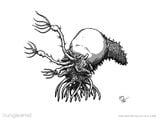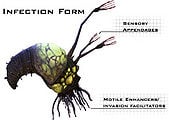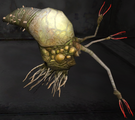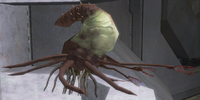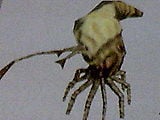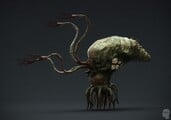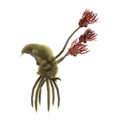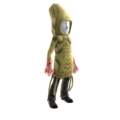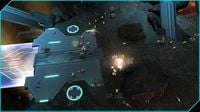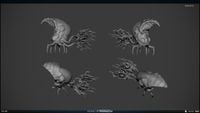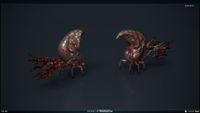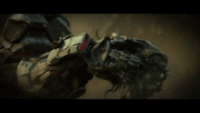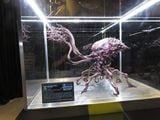User:JackVibe/Sandbox: Difference between revisions
From Halopedia, the Halo wiki
No edit summary Tag: Reverted |
No edit summary Tag: Reverted |
||
| Line 146: | Line 146: | ||
{{Flood}} | {{Flood}} | ||
[[Category:Flood forms]] | [[Category:Flood forms]] | ||
<!-- | |||
At the end of ''Halo 2'', we thought it would be a really cool idea if we got a lot of people involved with making small multiplayer maps. | |||
People spend most time on multiplayer maps, not in the single player ones | |||
the importance of all the different things you can do is wildly changing | |||
it's easy to get the concept I'm here to defend the space | |||
so we split into four groups | |||
fresh ideas | |||
non-stop action | |||
bang bang bang | |||
frantic game of whack-a-mole | |||
a lot of new eyes | |||
definitely see stuff that you're like how the hell did they do that | |||
think you're exaggerating | |||
swing | |||
just like everybody else we were getting a little bit tired of playing some of the same maps over and over so it was a great opportunity to get more maps out there | |||
double kill triple he'll killtacularx | |||
containment is a big map | |||
it's definitely the biggest map in the downloadable content | |||
two team capture the flag eight on eight | |||
this map is so big the xbox can't even hold it we are visiting the quarantine zone. these zones were created | |||
by the sentinels in order to prevent the flood from escaping further and infecting even more of the halo structure | |||
it was supposed to be just a straight-up conversion of timberland from halo pc | |||
the bases are more intricate | |||
because they're basically the sidewinder basis | |||
make it more interesting | |||
change it even further | |||
more dynamic | |||
just change it altogether | |||
two rocket launchers | |||
there's also two sniper rifles | |||
two warthogs a banshee and an outside of your wall is a tank | |||
we tried to do some things the other big maps didn't: incorporate the tank hopefully effectively this time | |||
this sort of flesh out their ideas with Max or riding shotgun over all of them making sure that they're not getting too crazy | |||
if we were going to have what we call boo bags they would just be these clusters of these boogers all over the level thatwould explode and harm you max decided that they bounced too much so he made them pretty static | |||
if they're gonna make a change for artistic reasons it's really helpful when they also can think if it will affect gameplay | |||
whenever you ask cotton or Paul about it they get pretty upset because they like them but really works | |||
you wonder why this map took three months to make | |||
there wasn't really impress event for for bossing testicles of deaths I hate video games what | |||
backwash is a humid environment. In all our other multiplayer maps you can see another player from a quarter mile away. Here you cant | |||
we knew we had to make small like four player Slayer style map[ the idea came up to use the halo 1 swamp is this foggy arena | |||
old and crusty forerunner | |||
we're saying this is on the Delta halo and it's actually an area very similar to the place on the alpha halo where the chief met Guilty Spark in fact we actually have monitor of the | |||
Delta halo he's flying around the environment we definitely were looking to encourage the short game so you'd be more inclined to use weapons like shotguns and the sword it's very easy to spawn and instantly see where everybody's fighting because you see plasma bolts in the fog and you know exactly where everybody is you just go | |||
charging over there | |||
and Nathan's favorite tactics to get up here on this little metal protrusion that he's just lobbing grenades down at people Im kind of the resident greeter I kill everybody on my team laughing the top of my lung | |||
Nathan's griefing is is a well balanced by his lack of skill yeah | |||
no one likes Nathan you know this map will be a success of people love with less Slayer halo at its simplest form it should be one of the places where it's just fun to find the high spots and gain elevation through jumping and when you do that you pull it off um no I feel like a halo God | |||
and we got glow bugs it doesn't get any better than that | |||
terminal is a train terminal exists in New mombasa | |||
supposed to be Zanzibar plus | |||
what if we took sands par to the next level what would that map be | |||
it's completely asymmetrical there are two bases but it's not a mirrored environment or an environment that is rotated so it's identical on both sides the nature of it is it's imbalanced so the attackers have a starting location and the defenders have a base but they're not equal unlike which one is easier to defend or easier to attack | |||
the only real dynamic element is the Train | |||
play too close to the tracks will die | |||
most of our halo 2 maps playing single flag CTF the vehicles are fun but they're not a key component of how you | |||
win or lose that and we wanted to make a vehicle encounter significant you cannot ignore the rave the Wraith is a big deal you need to take out the race if you're an attacker if you're a defender you want to preserve the raid | |||
everything that we're thinking about is balanced put a lot of thought into making sure that a guy on the foot can destroy that vehicle | |||
no rocket model rocket our Akash | |||
this big design issue | |||
I think they've actually just softened on that position\ a little bit there's now a rocket on terminal | |||
okay people who are good with the Wraith we've added the rocket launcher back in the terminal which we didn't want to do in the first place we tread in specifically designed this map so we didn't have to use the rocket | |||
launcher but now because people have gotten so good with the Wraith the rocket launchers back in there | |||
it's pretty rare that you'll get people just sitting in a spot and being cowardly hate cowards | |||
this is a remake of longest one of the maps in halo 1 | |||
supposed to be this dirty cargo freighter two parallel hallways with bases at either corner you can see earth | |||
you can see the moon I thought about it I really hated about longest that I wanted to fix ladders really destroy the | |||
realism | |||
I've never seen the ladder right like | |||
you have this vertical motion but you don't see your hands doing that | |||
we got rid of all the ladders | |||
everybody | |||
hated ladders it's a really nice thing about this map is that there's total mobility it's a fairly simple map so | |||
that it's easy to navigate easy to understand | |||
one of the ways that you can get to the second floor from the ground for is to take advantage of these boxes | |||
that are moving around | |||
gameplay-wise the crates of her huge change because they create this jumping path that you can get between the two levels on the map from any point | |||
one of the interesting things that just kind of fell out of this design and this is not intentional | |||
if you are on the conveyor belt even though you're moving faster than the motion sensor if you're standing still | |||
don't show up it has like this one thing that we've never had before which is you can hide and actually end up with a different spot than you were and the whole time will be on the motion sensor | |||
I wanted to put the ladders back in but make them slanted so that you didn't have the same horrible problems that you did they never expressed that though | |||
I never expressed that when | |||
he were to get shot | |||
it would have been a problem | |||
Relic Big Island the original idea came from the very first halo multiplayer map back on the pc 44 that's kind of the sweet spot for that map | |||
the more people that gets a little more chaotic we were looking for a asymmetric one flag CTF map that played differently than any of the others | |||
it's designed specifically to have a unique experience for capture the flag | |||
it's set up and have the side that is protecting the flag so there's always an attacker and defender keeping the entire map in play at all times | |||
it totally changes the way the two side behave one of the smart routes to go is down here by the beach | |||
because that's where the rocket launcher is | |||
both sides trying to fight to get that as quickly as possible | |||
you take the quick route and run out me open to get to the base or did you take the longer but safer route I mean there's a trade-off we intentionally make it so that the fastest route is the straight line that's running the gauntlet so it's risk versus reward | |||
scoping out over the entire island is really cool because you can see people coming up through the rocks Gillian's free junk you | |||
there's a contest to go and get the rocket launcher much like there's a contest to get the sniper rifle and you have to make real conscious decisions about what's important to you to win this map | |||
[Music] | |||
it's Gemini | |||
its origin is in marathon | |||
in Marathon infinity there is a map called duality that's the fundamental structure that we took it's not really a | |||
symmetrical or asymmetrical map it's an arena free fall map | |||
we wanted it to feel fully otherworldly this isn't something for the rest of the Covenant this is the prophets antechamber the two rooms two ramps in the lower lobby | |||
the teleporters that let you rapidly move to another part of the map the door see really\mundane but a door actually lets you play with the person that's what this is | |||
corridors cool moody lighting lots of | |||
artfully well-placed weapons and good | |||
comments so that's the essence of a good | |||
ground powder even walking slowly I can | |||
cover the entire map in about 15 seconds | |||
that makes it very difficult to actually | |||
mount a defense our engine is designed | |||
for a mix of different weapons that work | |||
at different ranges you can only carry | |||
two the reason you pick up to plasma | |||
rifles is not so you can squeeze both | |||
triggers at the same time it so that you | |||
can post them like you can fire one | |||
until it burns and then fire together | |||
while the other ones cooling off because | |||
if you need to reload them in your dual | |||
wielding that you're basically screwed | |||
I really wanted to have a lot of small | |||
maps warlock had a characteristic me for | |||
wasting interval radially symmetrical | |||
it's designed to be completely equal | |||
warlock is uh is based on the original | |||
halo one map a wizard and for those that | |||
played halo 1 multiplayer this is gonna | |||
be like an old friend they're gonna | |||
immediately walk into this map and be | |||
like oh I know what's happening I'd be | |||
fairly easy to get more lock up to speed | |||
considering that the geometry already | |||
existed we had to mark off each base | |||
with a different color so that you | |||
wouldn't get lost and it's pretty easy | |||
to get lost in a place where every four | |||
of the coroner's look identical the game | |||
is really giving you something that you | |||
look at is something that you here we | |||
have almost 36 styles and pieces of | |||
audio that went into halo 2 territory | |||
with 64 surround sound voices and if | |||
you're playing multiplayer and you have | |||
a big battle going on around you you are | |||
probably more than likely hitting that | |||
62 64 voice limit pretty easily lost the | |||
lead if you look at it and you think it | |||
should make sound we try to make it mix | |||
them I put some things like there's bats | |||
up no bed so I think there have been | |||
there somewhere I'm sure yeah I mean I I | |||
know that we don't have any so that's no | |||
no bad | |||
[Music] | |||
sanctuary is about battle that takes | |||
place on the Delta halo you can envision | |||
Delta temple being in the distance | |||
behind the cliff behind the waterfall it | |||
should look like a single player man but | |||
play like a multiplayer map it sold for | |||
runner architecture supported by some | |||
newer forerunner metal structures it's | |||
really important to us that people | |||
believe that they are real places in our | |||
universe first is just a high-level | |||
strategy just a plan from there we go to | |||
paper design which is the designer and | |||
the artist working together it actually | |||
is a symmetrical map symmetrical is | |||
mirrored in some fashion and it's an | |||
attempted to try to make things balanced | |||
a map confuse but there's a subtle like | |||
sniper advantage to one side or the | |||
other what it was designed for a CTF | |||
might take the medium range weapons like | |||
the battle rifle and the carbine SMG you | |||
got a needler those are all | |||
symmetrically placed to give each team | |||
even playing field every time they take | |||
on one of those weapons are taking on a | |||
role that's kind of mentality I take you | |||
know designing spaces are there good | |||
places for a player to assume those | |||
roles and be effective in are there | |||
places for players to fight against that | |||
role as well | |||
[Music] | |||
turf turf is a medium to small map | |||
setting old Mombasa sort of early in the | |||
invasion before this stuff really starts | |||
hitting the fan | |||
Oh busted us on my favorite part in the | |||
single-player inhaler to seeing certain | |||
landmarks from a single player game in | |||
the distance the bridge just gives it | |||
such a great feel | |||
it's got lots of cover lots of very | |||
small scale interconnections more close | |||
quarters combat it's meant for a match | |||
between two small teams we really wanted | |||
to work on a map that really featured a | |||
new game type that we had hail with two | |||
called territories territory server | |||
requires a map that is designed for the | |||
game territories is the game where the | |||
objective is to capture and control the | |||
territories territory control as you | |||
control them you gain time and you win | |||
the game by having the most time the | |||
more control you have the more tenuous | |||
that control is as you're controlling a | |||
larger area than that you have to divide | |||
your attention over a much greater space | |||
so that it's easier for the underdog to | |||
come in jarrett ori lost we have a | |||
street territorial which is being themed | |||
as a marine headquarters the opposite | |||
corner we have a warehouse territory and | |||
then at the third quarter we have a | |||
scare although in Halo linga lot they | |||
called plots no they're just territories | |||
in the UI doesnt say plots well it's | |||
called three plots for the three | |||
retailers therefore yes and hannah am I | |||
being too verbose | |||
this is going to be the easiest map to | |||
navigate and learn so everyone always | |||
wants to do a little bit more than they | |||
probably can we always overshoot and | |||
then come back put it in rip it out this | |||
map has probably had the most work done | |||
on of all the maps | |||
[Music] | |||
saying the detail that's on here this is | |||
probably my favorite halo map thus far | |||
it's awesome I love his mouth I like it | |||
it's fun Matt and I did no work as a | |||
game developer you really get to enjoy | |||
two games one is the game of creating | |||
the systems in the art itself and then | |||
the other one is to actually play test | |||
it the rest of the staff is working on | |||
all these maps what was the animation | |||
team gonna be the only part of this | |||
process was getting everybody to take on | |||
a new challenge and even expand those | |||
skills in new ways that they hadn't | |||
thought of before so that was a great | |||
opportunity to get a cinematic together | |||
we looked at the way we combined | |||
animation and sound and everything else | |||
into the cinematics and halo 2 and how | |||
we can make that process better we | |||
didn't feel like our pipeline was really | |||
well thought out and we wanted to go | |||
through it again and come up with new | |||
tools they're all like well let's do a | |||
short film | |||
status I wanted to do something that | |||
kind of paralleled what happened in the | |||
game Marines at the beginning birth city | |||
is one of those kind of tangents that | |||
you see the beginning of and you see the | |||
end of but you never really hear what | |||
happened the third Pelican kind of flies | |||
by and halfway through that level youth | |||
see that same Pelican crashing on the | |||
beach and you meet up with the Marines | |||
that were in it but you never really | |||
found out what happened to them felt | |||
like a good place where you can tie in | |||
both the beginning and the end actual | |||
gameplay just placing the master chief | |||
in the scene and this shot that I'm | |||
working on right now is the very first | |||
shot this shot right here is where the | |||
Pelican is just crashed you see phones | |||
checking checking the corpse of O'Brien | |||
we're actually gonna be able to fly the | |||
Pelican around in a space and capture | |||
five got one audio of it be able to | |||
embed that the cinematic in a way that | |||
we weren't able to in the game engine | |||
that's actually me I'm the one with the | |||
plasma and that's Jeremy over here and | |||
bells dead of course of the jackal is a | |||
good character we killed bill up pretty | |||
quickly anything hollywood it is going | |||
to be free rendered so it's a little bit | |||
different than the cinematics that occur | |||
in game we're still using the game | |||
engine to render it but since it's not | |||
rendering in real time we're able to do | |||
a lip feel there are effects and more | |||
lighting stuff Oh everybody is really | |||
getting to do the things that they love | |||
to do to work on the things that they | |||
love working on because it was something | |||
that we were doing for fun it was a | |||
learning exercise it was all just a lot | |||
of really good experience for everybody | |||
on the team we have a long road ahead of | |||
us I won't lie but yeah it's pretty cool | |||
it's actually really fun time to be | |||
working here I would definitely say this | |||
is wet the whistle for for what comes | |||
next we better get moving agreed | |||
--> | |||
Revision as of 10:20, July 25, 2024
| This article does not meet the wiki's general standards and/or standards on layouts. You can help by cleaning this article. |
| This article does not have enough inline citations and/or does not adhere to the proper citation format. You can help Halopedia by adding citations. |
| Pod infector | |
|---|---|
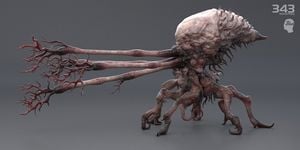
| |
| Biological overview | |
|
Classification: |
|
|
Species: |
|
| Physical information | |
|
Avg. height: |
89.6 centimeters (2 ft 11.3 in)-131.4 centimeters (4 ft 3.7 in)[1] |
|
Avg. weight: |
16.8 kilograms (37 lb)-28.6 kilograms (63 lb)[1] |
|
Distinctions: |
Small, sac-like creatures with many tentacles for probing. |
The pod infector,[2] often ubiquitously called the Flood infection form,[3][4] is a stage of the virulent Flood xenoform. It serves as the primary form for spreading the Flood infection due to its effectiveness compared to mere Flood spores when deployed in large numbers. Subsequently, it is usually the first Flood forms to be produced as well as the most commonly encountered Flood form.[2]
Overview
Physical characteristics
Pod infectors have soft, pod-shaped bodies; they are characterized by a small, sagging brown lobe rising from the top of its back,[3] while its frontal surface has numerous tentacle-like appendages and a frond-like array, which acts as the creature's sensory system.[5][4] Their tendrils are multi-purpose locomotion systems and insidious methods of control.[5][4] Used for attacking and infecting organisms,[6] each tendril ends in nano-scale barbs, which can latch onto a target's body, slice open bare skin,[7] and even cut through armor or environmental suits.[5][4] The pod infector's bulbous body is filled with noxious gases,[4] while its numerous tentacles allow them to travel at high rates of speed and leap surprising distances in pursuit of a host.[1]
The pod infector does not feel pain or fear.[8] Though barely intelligent on their own, once an infection form infiltrates a sentient creature, they turn the victim's cognitive power to the furtherance of Flood goals. Each pod infector able to sift through memories of any sentient creature to learn of military countermeasures, security access codes, and the location of population centers. This information is then shared with other Flood through their connection with the key minds.[5]
Function
Pod infectors develop from a form vaguely resembling a larva or tadpole but bearing the basic superficial characteristics of a Pod infector. A number of Flood forms in this stage of their life cycle were kept in stasis by the Forerunners in Flood research facilities, such as the one in the Threshold gas mine.[9]
Serving as the primary vector for the Flood infection, pod infectors usually attack en masse, overwhelming and overpowering their prey, until one is able to burrow into the victim's flesh,[1] As with other infection forms, the pod infector has an array of "penetrators", which are barbed tentacles that can cut through flesh and armor.[5][4] When a pod infector attacks a victim, its tentacles insert into the spine,[10] with the goal of invading the target's central nervous system,[11] which then initiates a violent transformation.[1] Once the target is compromised, the pod infector injects Flood cells to suborn the victim's nervous system while the pod infector itself bores into the host body to hollow out a nest, quickly twisting the remains of its victim into a combat or carrier form.[4]
Due to the balloon-like qualities of the pod infector, it could deflate itself to fit inside the victim's body.[12] Even if the infection form is quickly removed, Flood cells in the wounds will slowly consume the victim and turn them into quivering, spore-packed blisters. Against unprepared victims the infection form bores into the body, quickly mutating it into a combat form.[5] If the infected host has sufficient biomass for self-sustenance, it will mutate neurologically and physiologically into a combat form.[13] The pod infector is capable of augmenting its new body and repair minor damage;[8] as such, combat forms typically possess unnatural physical strength, perhaps gained through the mutation of the host's musculoskeletal structures.[13] Otherwise, sections of the host's body are consumed and converted into FSC, with much of their internal organs being consumed and replaced with FSC accretions that function as support lattices. Some limbs and sensory organs are retained on the combat form to enable use of tools, weapons, or vehicles; though the pod infector sees the environment using its own sensory organs—often the flexible fronds or antennae on the end of narrow tendrils—and whatever remains of the host's native senses are usually redundant and ignored.[8] In some circumstance, the pod infector is unable to completely dominate the original personality and the victim remains fully aware of their irrevocable transformation and their being used as a tool of the Flood. Though their bodies are bent to the Flood's will, occasionally the victim can still whisper for mercy or cry out in pain. More often, the parasite will speak on their behalf, using stolen thoughts and memories as a psychological weapon, terrorizing both the host and anyone unfortunate enough to be within earshot.[8][14] This was the fate of Wallace Jenkins during the Battle of Installation 04; a pod infector had been severely weakened during long periods of hibernation, and while strong enough to take over and transform Jenkins' body, it lacked the force and clarity to completely control Jenkins.[15] With the Flood mind weakened, Jenkins survived infection, and even remained conscious, with short periods of time where he could exert control over his mutated body.[16][17]
A Pod infector may abandon its host if the corpse has been heavily damaged, and look for a new one. If the Pod infector inside a combat form has been destroyed, but the combat form itself is intact enough to continue serving its purpose, loose Pod infector may burrow inside the body and take the place of the one that mutated it, effectively "re-animating" the combat form.
Once the parasite can establish a hive, it can begin to produce massive numbers of infection forms that spread out in search of new sentients to infect, and non-sapient animals on which to feed. Both ground and airborne infection forms are used as living weapons, hurling themselves at the enemy to overwhelm defenses and assimilate the unprepared.[4] The Flood blister itself is an infection form, incubating spores as well as carrying pod infectors; when ruptured, the blister releases the pod infectors.[18][19] Carrier forms serve as mobile incubators of pod infectors; when they are in close range of enemies, or when their sacs are perforated, they rapidly swell and then detonate,[13] releasing pod infectors being held within.[20] Flood pure forms, including the spawner form and the tank form, are known to gestate pod infectors to spread the Flood infection.[21][22]
Once this is accomplished, the form rewrites the neural pathways of the victim's brain with its tendrils, forcing a resonant frequency match between its neural signals and the host's.[citation needed] At this point, the Pod infector has complete control over the body's motor functions.
As the Pod infector hacks into the host's nervous system, it releases encapsulated Flood Super Cells into the body. These cells interface with the host's cells, "digest" them and convert their components into new Flood cells.[citation needed] At this point, the Pod infector burrows into the host body, moving aside the internal organs and taking up residence within the chest cavity (or any approximate equivalent). Having achieved total control over the host, the Pod infector reshapes the body into a form more suitable for attacking enemies - a combat form.
While an effective vector of infection against armored and shielded organisms as well as those equipped with atmospheric filters, a Pod infector is not necessary for the Flood to infect a host; merely ingesting Flood spores or inserting them via a wound is sufficient to initiate Flood conversion. Such infection may occur several seconds or perhaps minutes later, yet the transformation will occur almost instantaneously once it has begun.[23][24]
Effects on host forms
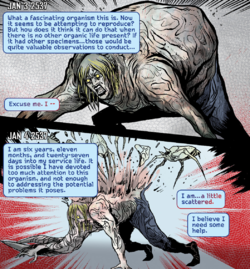
While any large life form with some level of awareness and/or sentience can be infected by a Pod infector, not all of them are suitable to serve the function of Combat Forms, the Flood's signature and preferred mobile form utilized during the Feral Stage. While these hosts are transformed in a similar fashion to the traditional combat forms, these forms are not often employed in front line combat for several reasons.
The first of these would be the fact that such life forms, despite their sophisticated nervous systems and adequate levels of sentience, simply lack the necessary biomass, calcium reserves, and physical strength to make first-choice combat units. More specifically, when a host life form is transformed, the activities of the Pod infector require not only the aforementioned levels of biomass, calcium content, and strength (Though humans become combat forms more often than the much larger and stronger unggoy for whatever reason.) but that the host has the physical endurance and stamina to withstand the process. Species such as humans, Forerunners, Sangheili, and the Jiralhanae are almost always turned into combat forms because their biology and physical properties enable them to withstand the Pod infectors' abilities, which are violent and resource-intensive.
In contrast, other life forms, such as the Kig-Yar, and perhaps the Yanme'e, lack these important qualities, or in the case of the Unggoy have other limitations due to their physique despite their perfectly adequate levels of sentience and neural complexity. Because of these factors, these hosts are primarily used for other but equally important purposes. These involve multiple mission profiles that are essential to the development of Flood outgrowth: establishment of mobile incubators, biomass and calcium reserves, hive structures, and the components of a coordinating and controlling intelligence.
When utilized for the creation of the hive and the central intelligence, the weaker hosts gather together and merge into single mass or a collection of masses spread around whatever environment the Flood have established themselves in. In this way, the weaker host forms serve as 'building blocks' for the creation of a Flood Hive, which if all goes according to its logical conclusion, will spawn a fully-developed collective and the next stage of the Flood's development: the Coordinated Stage and its crowning achievement, a Gravemind. Surrounding life forms such as significantly smaller animals as well as the full range of plants, microbes, lichens, and fungi, are seized by the growing Flood collective and digested as raw material to create more generic Flood biomass.
The next vital use for lesser hosts is to serve as the second signature form of the Feral Stage, the mobile Pod infector incubator known as a Carrier Form. While these are usually formed from weakened, damaged, and/or aged Combat Forms, weaker host forms are just as frequently employed for this purpose. The first step in the creation of a Carrier Form by this method involves a single appropriate host to function as a nucleus, which is then followed by one or more other weaker forms attaching themselves to the leading unit. The congregated hosts then fuse, with the external host forms being rapidly digested by the central form, with the result being that the other hosts have been reduced to extra, generic biomass, contributing to the structure of the now significantly distorted, bloated incubator.[25]
While this complex methodology is largely standard procedure for the Flood, there are occasionally exceptions to these rules due to the Flood's adaptive nature. In at least one notable campaign[26] early in the Human-Covenant War, this mode of operation was contradicted by the Flood. The outbreak present on this installation employed Kig-Yar and Unggoy quite frequently as front line combat units despite their inadequate status, and was also distinct from other outbreaks with the fact that it was predominantly formed out of life forms lacking sentience such as plants, fungi, etc., or those possessing lower levels of sentience, such as the wide range of animals living there.
Immunities and defenses
Energy shielding destroys Pod infectors on contact, causing them to explode in a small burst of gas and flesh. Conventional body armor is generally ineffective against Pod infectors; they can easily squeeze through gaps in armor plating, and their grasping tentacles can burrow through rubber, fabric or polymer (including MJLONIR MK V undersuits) in order to reach the flesh underneath.
Staff Sergeant Avery Johnson was thought by Dr. Catherine Halsey to be incompatible with Flood Pod infectors due to the fictitious "Boren's Syndrome"[27] — in reality a cover for the augmentations he received as part of the ORION Project.[28] However, it is apparent that Johnson's augmentations did not make him truly immune to the Flood conversion process itself, instead granting him the ability to fight off and escape the parasite more effectively than the baseline humans alongside him.[29][30][31]
The Mgalekgolo's lack of a central nervous system and nature as an invertebrate colony consisting of multiple worms likely make them immune to Flood infection.[32] The invertebrate nature of the Yanme'e, along with their hard, chitinous exoskeleton, would seem to make them immune as well. However, while their unique physiologies make standard infection difficult, it is likely that the Flood are still capable of consuming and converting Lekgolo and Yanme'e into Flood biomass.
Trivia

|
See our gameplay information related to JackVibe/Sandbox on its gameplay page. |
- In Halo: Combat Evolved, if a Pod infector latches itself onto a Marine or one of the Covenant, instead of mutating the host, it will become irrevocably attached until the host is dead. If at least one Pod infector manages to leap onto an unshielded player in this game, it will deal a noticeable amount of damage (this will increase depending on difficulty and number of Pod infectors attached), fall off, and attempt to strike the player again. This effect on the player also appears in Halo 3.
- An energy sword will not lose energy by killing Pod infectors in Halo 2 and Halo 3, but this method is highly ineffective as Pod infectors are extremely hard to hit with an Energy Sword.
- Pod infectors do not add points to the player's meta-score when the campaign scoring is activated in Halo 3 and Halo: The Master Chief Collection. This is most likely because Pod infectors come in swarms, and could be used to rack up points with almost no effort.
- Unlike in Halo: Combat Evolved and Halo 2, the Pod infectors in Halo 3 float in water. Thus, they cannot infect corpses that are in water ponds because of this animation.
- In Halo Wars, when Sergeant Forge shoots the Flood Pod infectors that are attacking Professor Anders, they do not pop like all other Pod infectors. Instead, they simply fall lifelessly to the ground.
- In Halo 3, code exists for a deleted "banger" variant of Pod infector, which would explode like a plasma grenade when destroyed.[33]
- In Halo: Combat Evolved, Pod infectors are not affected by fall damage, most likely due to the script or slow speed during freefall.
Gallery
Flood Pod infector in Halo: Combat Evolved.
A Pod infector in the Threshold gas mine in Halo 2.
Render of the Halo 2 Pod infector in Halo: The Master Chief Collection.
Pod infectors in Halo 3.
A Pod infector in Halo Wars.
Pod infectors assaulting Professor Anders.
An Xbox 360 Avatar customized with a Flood Pod infector suit.
A Flood Pod infector inside the UNSC Spirit of Fire's cryo-room in Halo: Escalation.
Flood Pod infectors in Halo: Spartan Assault.
Jerome-092 destroying a Pod infector in a single punch in Something has Happened.
Models of the Pod infector for Halo Wars 2.
An infection form at Outpost Discovery.
A Pod infector trapped in a Cylix on Installation 07 in Halo Infinite.
List of appearances
|
Sources
- ^ a b c d e Halo: Combat Evolved Anniversary, Library: Infection Form
- ^ a b Halo Wars 2, Phoenix Logs: Pod Infectors
- ^ a b Halo Encyclopedia (2011 edition), page 164
- ^ a b c d e f g h Halo Encyclopedia (2022 edition), page 406
- ^ a b c d e f Halo Wars 2, Phoenix Logs: Infection Forms
- ^ Halo Encyclopedia (2011 edition), page 180
- ^ Halo: The Flood, chapter 12: "The Spartan gave a cry of pain, felt the tentacle slide down toward his spine, and knew it was over."
- ^ a b c d Halo Encyclopedia (2022 edition), page 408
- ^ Bungie.net: One Final Effort (4/16/2010)
- ^ Halo: The Flood, chapter 9: "...because ever since the infection form had inserted its penetrator into his spine, Private Wallace A. Jenkins had been sharing his physical form with something he thought of as "the other.""
- ^ Halo: The Flood, chapter 10: "...it has tentacles in place of legs, plus a couple of extremely sharp penetrators, which they use to invade the victim's central nervous system and take control of it."
- ^ Halo: The Flood, chapter 10: "If you peek through the hole in her chest you can see the remains of the infection form that deflated itself enough to fit in around her heart and lungs."
- ^ a b c Halo Encyclopedia (2011 edition), page 165
- ^ Halo Wars 2, Phoenix Logs: Infected
- ^ Halo: The Flood, chapter 6: "Due to some fluke, some random toss of the galactic dice, the mind that invaded his body had been severely weakened during the long period of hibernation, and while strong enough to take over and begin the work necessary to create a combat form, it lacked the force and clarity required to completely dominate its host the way it was supposed to."
- ^ Halo: The Flood, chapter 10: "Jenkins had used pantomime to request a mirror. A well-meaning Corporal brought one in, held it up in front of the soldier's devastated face, and was frightened when he tried to scream."
- ^ Halo: The Flood, chapter 12: "Jenkins, still unable to speak, managed to mouth the words “thank you.”"
- ^ Halo 3, campaign level Cortana
- ^ Halo Encyclopedia (2022 edition), page 407
- ^ Halo Encyclopedia (2022 edition), page 409
- ^ Halo Encyclopedia (2011 edition), page 166
- ^ Halo Wars 2, Phoenix Logs: Spawners
- ^ Halo Wars, campaign level Anders' Signal
- ^ Halo: Evolutions — "The Mona Lisa"
- ^ 'Halo: The Flood', page 291
- ^ Halo Wars
- ^ Halo: First Strike, page 244
- ^ Halo Graphic Novel, page 122
- ^ Halo Waypoint: Catalog Interaction - Page 14 ("No known biological [scaffolding] augmentation impedes efficacy of parasite conversion process.")
- ^ Halo Graphic Novel, Breaking Quarantine
- ^ See Avery Johnson#Notes
- ^ Halo: First Strike
- ^ YouTube: Halo 3 - Cut Enemy: Flood Infection "Banger"
| |||||||||||||||||||||||||||||||||
